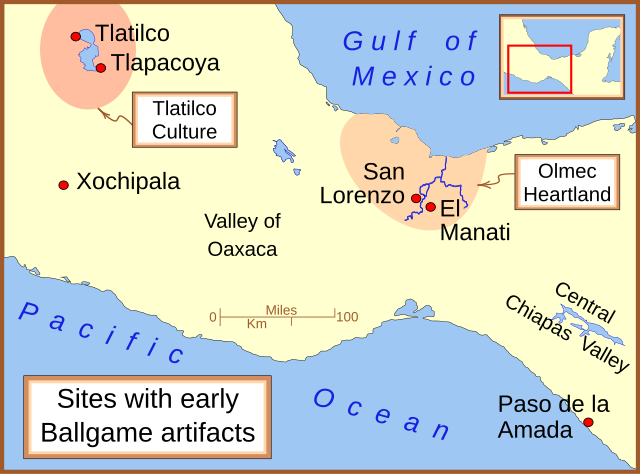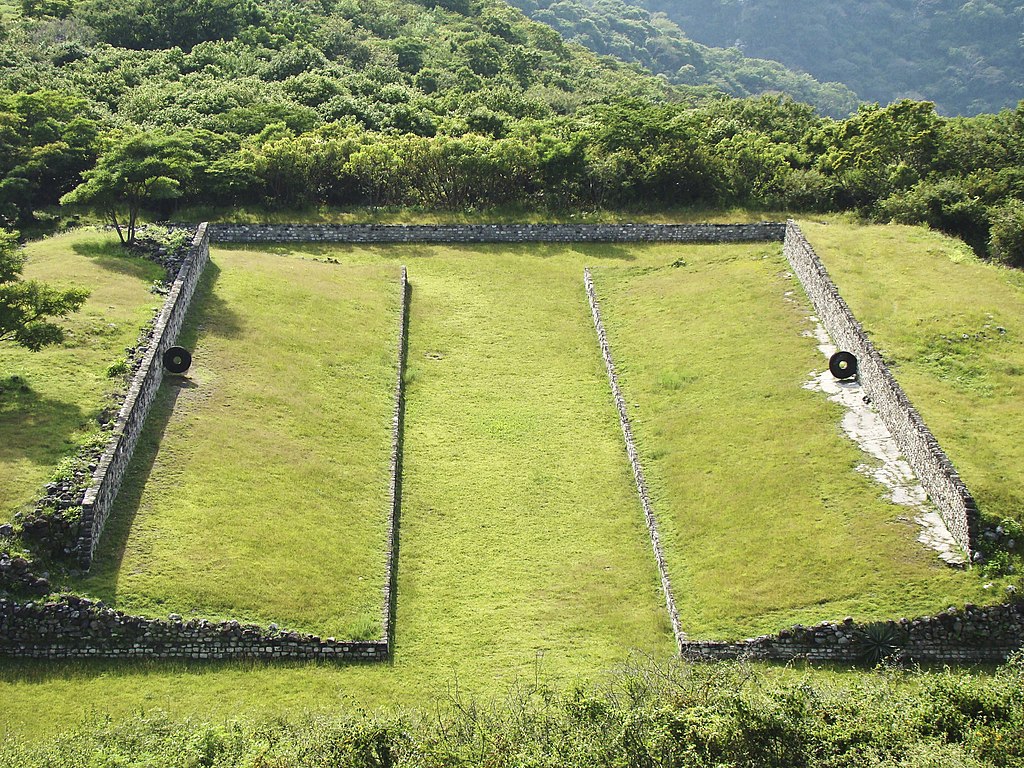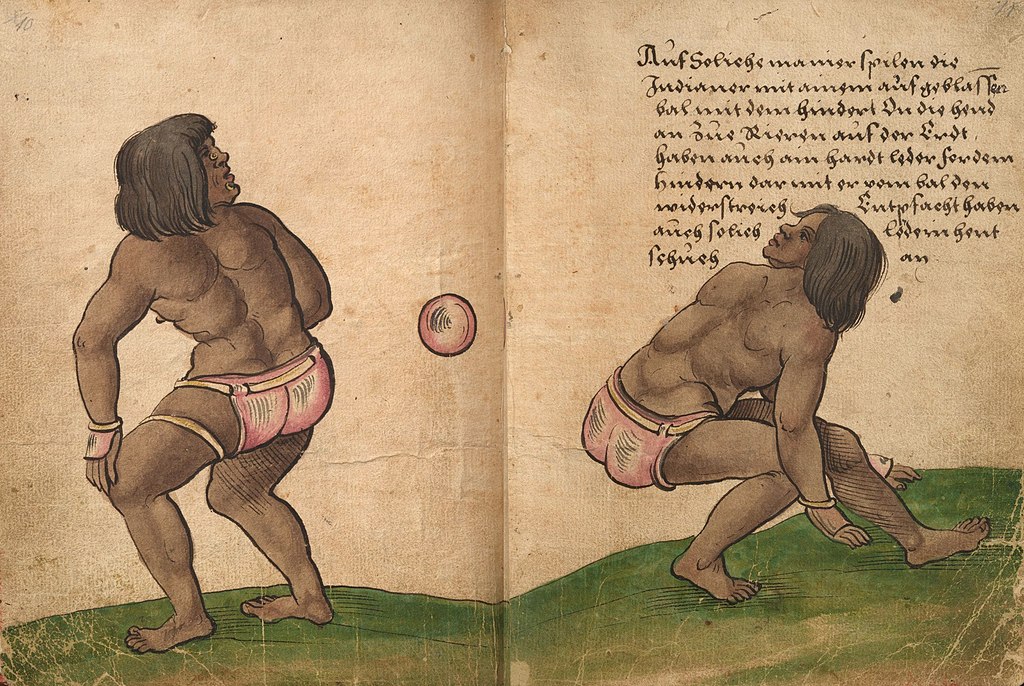For thousands of years, the ancient pre-Columbian people of Central America used to play a peculiar sport with ritual connotations, which was an important aspect of their culture. This sport is commonly known today as Mesoamerican ballgame, and it is called ōllamalīztli in Nahuatl languages and pitz in Mayan languages. Other names for the game are pok-ta-pok in English, or juego de pelota maya (or simply pelota maya) in Spanish. The game had various different versions, and the exact rules are not known, but a modernized version called ollama or ulama is played today.
The most well-known version of the game saw two teams of usually two, three, of four people compete against each other to keep the ball in play. The players had to struck the ball with their hips but, in some versions, using forearms or even rackets and bats was allowed. The balls were made of rubber and could vary in size, but were often between 25 and 30 cm, and weighed between 1.4 and 2.7 kg, but sometimes even up to 4 kg. Because of this, the game could be dangerous for players, who often suffered injuries caused by hitting the solid and heavy ball. Some players could even die when the ball hit them in the head or the stomach.
The games were played in ballcourts that could have widely different sizes, and had a long and narrow playing zone, with larger and sometimes enclosed areas on each end. However, the game could be also played casually outside ballcourts. Games were mostly played by adult men, but women were probably allowed to play too. Children also played the game for recreation, and the young Aztec nobles were even thought how to play in school.
The Mesoamerican ballgame probably originated before 2000 BCE around modern-day southern Mexico. The oldest ballcourt that was used as a venue to play this sport dates from 1400 BCE, and has been found in the Paso de la Amada archaeological site, located in the Mexican state of Chiapas near the border with Guatemala.
The area of southern Mexico where the Mesoamerican ballgame likely originated (Madman2001, Wikimedia Commons, CC BY-SA 3.0).
Another area where the Mesoamerican ballgame developed was in the Isthmus of Tehuantepec along the Gulf Coast of Mexico. This region was inhabited by the Olmecs, whose name comes from the Aztec Olmeca, meaning “rubber people”. In fact, this area was known for the production of rubber, and the earliest rubber balls were found here, in the El Manatí archaeological site. Numerous balls, ranging in diameter between 10 cm and 22 cm, have been uncovered, and the oldest ones date from around 1700 BCE. Some of the balls have been found as ritual offerings in burial sites, suggesting that the game was associated with religion and traditional rites.
Several figurines depicting ballplayers have been found in the nearby Olmec site of San Lorenzo Tenochtitlán, dating from around 1200 BCE. This site also featured a ballcourt dating between 600 BCE and 400 BCE. Ballplayer figurines dating from 1000 BCE have also been found more north, in the Tlatilco, Tlapacoya, and Xochipala archaeological sites of central Mexico.
Over the next few centuries the game reached new regions, and by 300 BCE it was widely played throughout Mesoamerica. More than 1,300 ballcourts have been found, mostly in Mexico, but also as far south as Nicaragua, and all the way north to the U.S. state of Arizona. The archaeological site of El Tajín houses the largest ballcourt by playing area, with a length of 126 meters. This was once the largest city of the Classical Veracruz culture, which was obsessed with the ballgame, and flourished from 600 to 1200. At least 18 ballcourts have been found in El Tajín, while the nearby site of Cantona had at least 24 ballcourts. The most famous and well preserved ballcourt is the Great Ball Court of Chichen Itza, a large Mayan city that also flourished between 600 and 1200. The playing area of this ballcourt is 95 meters long, but the entire structure measures 168 meters.
A ballcourt in the archaeological site of Xochicalco, Mexico (Paco Baeza, Wikimedia Commons, CC BY-SA 3.0).
The Mayans added a new element to the game starting from around 900 CE, placing vertical stone rings on each side of the court. With this innovation, the goal of the game was to pass the ball through the ring, an element which was later adopted also by the Toltecs and Aztecs. By the 16th century, a player could score a point in various ways, such as by hitting the ball on the opposite team’s wall. If a player let the ball bounce more than twice before returning it to the other team, let the ball go outside the court, or tried and failed to pass the ball through the ring, a point would be awarded to the other team. If a team could place the ball through the ring they would win the game. However, this was a rare event, and most games were won on points.
Many games were held as ritual events, and in the late history of the sport, some competitions were even associated with human sacrifice. This was not a common occurrence, and it seems like it did not involve actual players, but sometimes captives would be forced to play the ballgame, and the losers could be sacrificed. The sport sometimes also served as a replacement for warfare, and different teams would resolve conflicts and settle disputes with a game instead of a battle.
Ballgame players depicted by German painter Christoph Weiditz around 1528.
The popularity of the game declined with the Spanish colonization of Central America, and it was even banned because of its religious connotations. However, the game survived in areas were the Spanish presence was less prevalent, such as the Mexican state of Sinaloa. More recently, the game entered mainstream popular culture thanks to its appearance in the 2000 animated film The Road to El Dorado.
The sport, now known as ulama or ollama, has been revived in the past few decades. The modern game is usually played between teams of five or more players, and the goal is to keep the ball in play. Points can be scored in various ways, including making the ball cross the opposite team’s line, or when the other team lets the ball go out of bounds. As part of its revival, some tournaments have been held between teams from different countries such as Mexico, the United States, Belize, and Guatemala.




